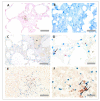Single and Multiplex Immunohistochemistry to Detect Platelets and Neutrophils in Rat and Porcine Tissues
- PMID: 36136817
- PMCID: PMC9498441
- DOI: 10.3390/mps5050071
Single and Multiplex Immunohistochemistry to Detect Platelets and Neutrophils in Rat and Porcine Tissues
Abstract
Platelet-neutrophil complexes (PNCs) occur during the inflammatory response to trauma and infections, and their interactions enable cell activation that can lead to tissue destruction. The ability to identify the accumulation and tissue localisation of PNCs is necessary to further understand their role in the organs associated with blast-induced shock wave trauma. Relevant experimental lung injury models often utilise pigs and rats, species for which immunohistochemistry protocols to detect platelets and neutrophils have yet to be established. Therefore, monoplex and multiplex immunohistochemistry protocols were established to evaluate the application of 22 commercially available antibodies to detect platelet (nine rat and five pig) and/or neutrophil (four rat and six pig) antigens identified as having potential selectivity for porcine or rat tissue, using lung and liver sections taken from models of polytrauma, including blast lung injury. Of the antibodies evaluated, one antibody was able to detect rat neutrophil elastase (on frozen and formalin-fixed paraffin embedded (FFPE) sections), and one antibody was successful in detecting rat CD61 (frozen sections only); whilst one antibody was able to detect porcine MPO (frozen and FFPE sections) and antibodies, targeting CD42b or CD49b antigens, were able to detect porcine platelets (frozen and FFPE and frozen, respectively). Staining procedures for platelet and neutrophil antigens were also successful in detecting the presence of PNCs in both rat and porcine tissue. We have, therefore, established protocols to allow for the detection of PNCs in lung and liver sections from porcine and rat models of trauma, which we anticipate should be of value to others interested in investigating these cell types in these species.
Keywords: immunohistochemistry; neutrophils; platelets; porcine; rat.
Conflict of interest statement
The authors declare no conflict of interest.
Figures








References
-
- Cleary S.J., Hobbs C., Amison R.T., Arnold S., O’Shaughnessy B.G., Lefrançais E., Mallavia B., Looney M.R., Page C.P., Pitchford S.C. LPS-induced Lung Platelet Recruitment Occurs Independently from Neutrophils, PSGL-1, and P-Selectin. Am. J. Respir. Cell Mol. Biol. 2019;61:232–243. doi: 10.1165/rcmb.2018-0182OC. - DOI - PMC - PubMed
LinkOut - more resources
Full Text Sources
Research Materials
Miscellaneous

